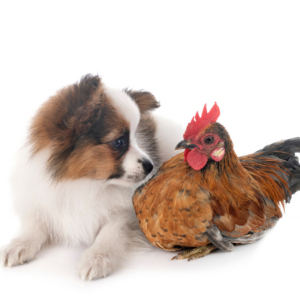Avian Flu: What you need to know to protect your dog
Can dogs get avian flu? Infectious disease expert and veterinarian Dr. Karren Prost joined us for a Q&A on avian influenza and its implications for our dogs.
Avian Flu: what is avian influenza?
There are four types of influenza viruses known. These include A, B, C and D. Influenza A is the most common, and the one that infects a large range of birds and mammals – including humans. All influenza A viruses start in birds, then eventually adapt to new hosts to form new strains, such as the canine strains (typically H3N2 or H3N8), or the seasonal influenza virus in humans that typically circulates in the fall and winter months in Canada.
Influenza A viruses are always spreading naturally between wild aquatic birds, such as ducks, geese, gulls, and shorebirds. The infected birds shed the virus in their saliva, respiratory secretions (mucus), and feces. The virus is transmitted by direct contact, or indirectly (such as contaminated clothing). In most cases, the wild waterfowl don’t get sick. When certain influenza A viruses are transmitted from waterfowl to another avian species, such as domestic poultry (or chicken), the chicken can become very sick. This would be what is called HPAI (high pathogenic avian influenza).

Scientists, veterinarians, and human doctors pay close attention to influenza viruses and particularly HPAI. They monitor these viruses closely due to their ability to constantly change, spillover and adapt to new hosts, causing disease. This year has also been a particularly bad year for the spread of H5N1 HPAI, with multiple outbreaks among poultry and waterfowl occurring in Canada. The more the virus spreads to other species, the higher the risk that the virus becomes easier to transmit among this new species causing severe disease, and eventually adapting to a new host (like humans).
Can dogs get avian flu?
Yes, but it is highly unusual. Dogs commonly get infected with canine strains of influenza viruses, but it is quite rare for them to test positive for those that circulate among birds.
Avian Flu Ontario: what happened?
This past April, multiple news sources reported that a dog in Oshawa, Ontario, developed clinical signs consistent with influenza a few days after chewing on a dead wild goose. The dog unfortunately eventually passed away and tested positive for the same strain of highly pathogenic avian influenza (HPAI) that was identified in the dead goose, or H5N1. Not surprisingly, this news caused significant fear and concern among pet owners.
What are the clinical signs of avian flu in dogs?
Some of the symptoms of HPAI closely resemble that of other respiratory infections seen in dogs caused by various bacteria or viruses.
These include:
- Fever
- Lethargy
- Conjunctivitis (eye infection)
- Coughing
- Runny nose
- Laboured or difficulty breathing
- Loss of appetite
- Neurological signs (tremors, or seizures)
Most dogs recover within a few weeks. Unfortunately some dogs can acquire a secondary infection and worsen, and death is possible.
My dog just chewed on waterfowls…what should I do?
The most prudent action would be to take preventive steps to avoid this from occurring. But in some cases, such as with very food-motivated Labradors, even the best measures can fail. If you find yourself in a situation where your dog is suddenly grazing on wild birds, the first step would be to separate your dog from the carcass…then take a deep breath. At this time, known cases of HPAI in dogs are rare. Closely monitor your dog for the next few days for the development of clinical signs (as stated above). If any of these clinical signs develop, contact your veterinarian immediately and inform them of their history of encountering a dead bird.
There are many, many causes of respiratory symptoms in dogs. Your veterinarian is the best option to determine the best step forward if testing needs to be performed, and what treatment options are advised. In certain cases where there is a history of possible exposure to HPAI and clinical signs, veterinarians can take throat, nasal and/or rectal swabs to send for testing.

In addition, take note of where the sick or dead bird was found, and report it to the Canadian Wildlife Health Cooperative, or your regional avian influenza hotline here: (Avian influenza in wild birds – Canada.ca)
If my dog ate bird poop, should I be concerned?
This one is a little less understood. Waterfowl can shed the virus in their feces. If there is enough virus in fresh feces from an infected bird, it could be transmitted to another animal. Similar precautions (close monitoring, contacting your veterinarian) are advised if you suddenly find your dog snacking on bird poop
What can I do to protect my dog against the avian flu?
Currently, the risk to dogs and their humans for HPAI is quite low. There are however a few steps and precautions you can take to reduce the risk even further for your dog. These include:
- Keep your dog away from wild birds, or their feces.
- Do not allow pets to consume or play with dead birds found outside.
- In high-risk areas (where there is waterfowl present), keep your dog on a leash to prevent them from accessing sick or dead birds.
- Do not feed your dog raw meat from game birds, or poultry.
While there are vaccines for canine influenza, these typically only target the flu strains more commonly associated with canine influenza and are unlikely to provide any cross-protection for HPAI.
If you found this blog informative and helpful, remember to register for our Waggle (e)Mail for exclusive offers, canine health and wellness tips, how-to’s, and more.

ABOUT THE AUTHOR
Dr. Karren Prost has wanted to become a veterinarian for as long as she could remember. During veterinary school, she developed an interest and passion for public health and infectious diseases. After veterinary school, Karren obtained her Master of Public Health (Epidemiology) and became boarded with the American College of Veterinary Preventive Medicine.

